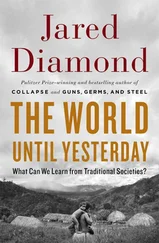Jared Diamond - Guns, Germs & Steel
Здесь есть возможность читать онлайн «Jared Diamond - Guns, Germs & Steel» весь текст электронной книги совершенно бесплатно (целиком полную версию без сокращений). В некоторых случаях можно слушать аудио, скачать через торрент в формате fb2 и присутствует краткое содержание. Жанр: 105. Описание произведения, (предисловие) а так же отзывы посетителей доступны на портале библиотеки ЛибКат.
- Название:Guns, Germs & Steel
- Автор:
- Жанр:
- Год:неизвестен
- ISBN:нет данных
- Рейтинг книги:5 / 5. Голосов: 1
-
Избранное:Добавить в избранное
- Отзывы:
-
Ваша оценка:
- 100
- 1
- 2
- 3
- 4
- 5
Guns, Germs & Steel: краткое содержание, описание и аннотация
Предлагаем к чтению аннотацию, описание, краткое содержание или предисловие (зависит от того, что написал сам автор книги «Guns, Germs & Steel»). Если вы не нашли необходимую информацию о книге — напишите в комментариях, мы постараемся отыскать её.
Guns, Germs & Steel — читать онлайн бесплатно полную книгу (весь текст) целиком
Ниже представлен текст книги, разбитый по страницам. Система сохранения места последней прочитанной страницы, позволяет с удобством читать онлайн бесплатно книгу «Guns, Germs & Steel», без необходимости каждый раз заново искать на чём Вы остановились. Поставьте закладку, и сможете в любой момент перейти на страницу, на которой закончили чтение.
Интервал:
Закладка:
I 6 Z • GUNS, GERMS, AND STEEL
tinents became an important reason why Eurasians, rather than peoples of other continents, were the ones to end up with guns, germs, and steel. How can we explain the concentration of the Ancient Fourteen in Eurasia? One reason is simple. Eurasia has the largest number of big terrestrial wild mammal species, whether or not ancestral to a domesticated species. Let's define a "candidate for domestication" as any terrestrial herbivorous or omnivorous mammal species (one not predominantly a carnivore) weighing on the average over 100 pounds (45 kilograms). Table 9.2 shows that Eurasia has the most candidates, 72 species, just as it has the most species in many other plant and animal groups. That's because Eurasia is the world's largest landmass, and it's also very diverse ecologically, with habitats ranging from extensive tropical rain forests, through temperate forests, deserts, and marshes, to equally extensive tundras. Sub-Saharan Africa has fewer candidates, 51 species, just as it has fewer species in most other plant and animal groups—because it's smaller and ecologically less diverse than Eurasia. Africa has smaller areas of tropical rain forest than does Southeast Asia, and no temperate habitats at all beyond latitude 37 degrees. As I discussed in Chapter 1, the Americas may formerly have had almost as many candidates as Africa, but most of America's big wild mammals (including its horses, most of its camels, and other species likely to have been domesticated had they survived) became extinct about 13,000 years ago. Australia, the smallest and most isolated continent, has always had far fewer species of big wild mammals than has Eurasia, Africa, or the Americas. Just as in the Americas, in Australia all of those few candidates
table 9.1 Mammalian Candidates for Domestication
Continent
Eurasia Sub-Saharan The Australia
Africa Americas
Candidates 72 51 24 1
Domesticated species 13 0 1 0
Percentage of candidates
domesticated 18% 0% 4% 0%
>> .—————
A "candidate" is defined as a species of terrestrial, herbivorous or omnivorous, *•*> mammal weighing on the average over 100 pounds.
ZEBRAS AND UNHAPPY MARRIAGES • 163
t the red kangaroo became extinct around the time of the continent's first colonization by humans.
Thus part of the explanation for Eurasia's having been the main site of hie mammal domestication is that it was the continent with the most candidate species of wild mammals to start out with, and lost the fewest candidates to extinction in the last 40,000 years. But the numbers in Table 9.2 warn us that that's not the whole explanation. It's also true that the per centage of candidates actually domesticated is highest in Eurasia (18 percent) and is especially low in sub-Saharan Africa (no species domesticated out of 51 candidates!). Particularly surprising is the large number of species of African and American mammals that were never domesticated, despite their having Eurasian close relatives or counterparts that were domesticated. Why were Eurasia's horses domesticated, but not Africa's zebras? Why Eurasia's pigs, but not American peccaries or Africa's three species of true wild pigs? Why Eurasia's five species of wild cattle (aurochs, water buffalo, yak, gaur, banteng), but not the African buffalo or American bison? Why the Asian mouflon sheep (ancestor of our domestic sheep), but not North American bighorn sheep?
did all those peoples of Africa, the Americas, and Australia, despite their enormous diversity, nonetheless share some cultural obstacles to domestication not shared with Eurasian peoples? For example, did Africa's abundance of big wild mammals, available to kill by hunting, make it superfluous for Africans to go to the trouble of tending domestic stock?
The answer to that question is unequivocal: No! The interpretation is refuted by five types of evidence: rapid acceptance of Eurasian domesticates by non-Eurasian peoples, the universal human penchant for keeping pets, the rapid domestication of the Ancient Fourteen, the repeated independent domestications of some of them, and the limited successes of modern efforts at further domestications.
First, when Eurasia's Major Five domestic mammals reached sub-saharan Africa, they were adopted by the most diverse African peoples wherever conditions permitted. Those African herders thereby achieved a "ge advantage over African hunter-gatherers and quickly displaced them. particular, Bantu farmers who acquired cows and sheep spread out of their homeland in West Africa and within a short time overran the former hunter-gatherers in most of the rest of sub-Saharan Africa. Even without
164 • GUNS, GERMS, AND STEEL
acquiring crops, Khoisan peoples who acquired cows and sheep around 2,000 years ago displaced Khoisan hunter-gatherers over much of southern Africa. The arrival of the domestic horse in West Africa transformed warfare there and turned the area into a set of kingdoms dependent on cavalry. The only factor that prevented horses from spreading beyond West Africa was trypanosome diseases borne by tsetse flies.
The same pattern repeated itself elsewhere in the world, whenever peoples lacking native wild mammal species suitable for domestication finally had the opportunity to acquire Eurasian domestic animals. European! horses were eagerly adopted by Native Americans in both North and South America, within a generation of the escape of horses from European settlements. For example, by the 19th century North America's Great Plains Indians were famous as expert horse-mounted warriors and bison hunters, but they did not even obtain horses until the late 17th century. Sheep acquired from Spaniards similarly transformed Navajo Indian society and led to, among other things, the weaving of the beautiful woolen blankets for which the Navajo have become renowned. Within a decade of Tasmania's settlement by Europeans with dogs, Aboriginal Tasmanians who had never before seen dogs, began to breed them in large numbers for use in hunting. Thus, among the thousands of culturally diverse native peoples of Australia, the Americas, and Africa, no universal cultural tat stood in the way of animal domestication.
Surely, if some local wild mammal species of those continents had domesticable, some Australian, American, and African peoples won have domesticated them and gained great advantage from them, just they benefited from the Eurasian domestic animals that they immediatel; adopted when those became available. For instance, consider all the pies of sub-Saharan Africa living within the range of wild zebras and 1 falo. Why wasn't there at least one African hunter-gatherer tribe domesticated those zebras and buffalo and that thereby gained sway other Africans, without having to await the arrival of Eurasian horses cattle? All these facts indicate that the explanation for the lack of nath mammal domestication outside Eurasia lay with the locally available mammals themselves, not with the local peoples.
A second type of evidence for the same interpretation comes pets. Keeping wild animals as pets, and taming them, constitute an initiq
ZEBRAS AND UNHAPPY MARRIAGES • 165
in domestication. But pets have been reported from virtually all traditional human societies on all continents. The variety of wild animals thus tamed is far greater than the variety eventually domesticated, and includes some species that we would scarcely have imagined as pets.
For example, in the New Guinea villages where I work, I often see people with pet kangaroos, possums, and birds ranging from flycatchers to ospreys. Most of these captives are eventually eaten, though some are kept just as pets. New Guineans even regularly capture chicks of wild cassowaries (an ostrich-like large, flightless bird) and raise them to eat as a delicacy even though captive adult cassowaries are extremely dangerous and now and then disembowel village people. Some Asian peoples tame eagles for use in hunting, although those powerful pets have also been known on occasion to kill their human handlers. Ancient Egyptians and Assyrians, and modern Indians, tamed cheetahs for use in hunting. Paintings made by ancient Egyptians show that they further tamed (not surprisingly) hoofed mammals such as gazelles and hartebeests, birds such as cranes, more surprisingly giraffes (which can be dangerous), and most astonishingly hyenas. African elephants were tamed in Roman times despite the obvious danger, and Asian elephants are still being tamed today. Perhaps the most unlikely pet is the European brown bear (the same species as the American grizzly bear), which the Ainu people of Japan regularly captured as young animals, tamed, and reared to kill and eat in a ritual ceremony.
Thus, many wild animal species reached the first stage in the sequence of animal-human relations leading to domestication, but only a few emerged at the other end of that sequence as domestic animals. Over a century ago, the British scientist Francis Galton summarized this discrepancy succinctly: "It would appear that every wild animal has had its chance of being domesticated, that note 8few … were domesticated long ago, but that the large remainder, who failed sometimes in only one small particular, are destined to perpetual wildness."
Datesof domestication provide a third line of evidence confirming galton's view that early herding peoples quickly domesticated all big mammal species suitable for being domesticated. All species for whose dates of domestication we have archaeological evidence were domesticated between about 8000 and 2500 b.c.—that is, within the first few thousand years of the sedentary farming-herding societies that arose after the end
Интервал:
Закладка:
Похожие книги на «Guns, Germs & Steel»
Представляем Вашему вниманию похожие книги на «Guns, Germs & Steel» списком для выбора. Мы отобрали схожую по названию и смыслу литературу в надежде предоставить читателям больше вариантов отыскать новые, интересные, ещё непрочитанные произведения.
Обсуждение, отзывы о книге «Guns, Germs & Steel» и просто собственные мнения читателей. Оставьте ваши комментарии, напишите, что Вы думаете о произведении, его смысле или главных героях. Укажите что конкретно понравилось, а что нет, и почему Вы так считаете.










